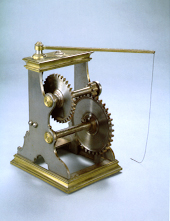
26 x 14.4 x 28.3
Steel and brass
INDEX 1788 : E.I.145
Machina cum duabus rotis, laternisque, ut proprietates Rotarum dentatarum demonstrentur; ut et Cocleae sine fine.
Machine with two wheels and lantern-wheel, to demonstrate the properties of cogwheels, and similarly of worm screws.
This machine, built according to the model in ´s Gravesande's Physices Elementa, allows one force to be balanced by another 5250 times smaller.
It consists of: an axle, A, 1.4 cm in diameter, bearing a 35-toothed cogwheel; another axle, B, with a small 7-toothed cogwheel engaging with the first, and another 35-toothed wheel; and a worm screw engaging with this. The screw is turned by means of a shaft, 21 cm in length, and the whole assembly turns with the screw.
A force is applied on a string fixed to the end of the shaft, and a load is hung from a cord which is wound around axle A, with its end caught in a ring on the axle. If we were to hold onto the string attached to the shaft, and go around with it, we would overcome the weight of the load, great as it is, with little effort. There are three multiplication factors of this machine: the ratio between the length of the shaft (21 cm) and the radius of the axle (0.7 cm), which equals 30; the ratio between the number of teeth of the cogwheel at A (35) and of the smaller wheel at B (7), which equals 5; and the number of teeth of the larger wheel at B (35, because this wheel does one complete revolution while the shaft turns 35 times). The weight of the load is, therefore, 30 x 5 x 35 = 5250 times greater than the force which balances it.
's Gravesande claims that the mechanism is capable of lifting 100 pounds (approximately 50 kgf) when the shaft is pulled by a hair. It is meant to sit on a table with a special hole in the top so that the weights can hang down.
This beautiful example, which works with remarkable ease, was built in Portugal, as can be seen by the inscription LIS. C. PIETRA.
From Colégio dos Nobres, catalogue n.º 136.
Carvalho, Rómulo de, História do Gabinete de Física da Universidade de Coimbra, Universidade de Coimbra, Biblioteca Geral, Coimbra, 1978, pp. 287-288.
's Gravesande, Willem Jacob, Physices Elementa, Leiden, 1742, Vol. I, § 304, Tab. XI, Fig. 5.